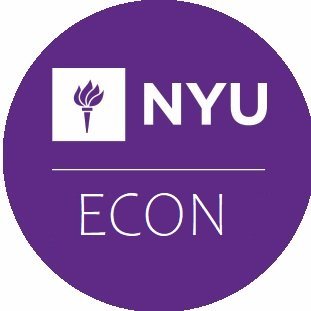
Gabriel Toledo
@gs_toledo
Followers
137
Following
152
Media
3
Statuses
27
VAP @ Daniels School of Business, Purdue University. Recent PhD from NYU. Macroeconomics with particular interests in Labor Search and Firm Organization.
New York
Joined April 2018
Hi, #EconTwitter! I want to share my JMP with you! How do firms find and replace managerial talent? Well, they can go out there and try to hire a good employee from another firm, which might be costly and involve frictions... ...or they can look for them inside the firm! (1/n)
1
25
70
Our featured job market candidate today is Kazimier Smith, an applied microeconomist using IO techniques to study the economics of online platforms.
1
6
22
Cesar Zambrano is a macroeconomist whose Job Market Paper uses survey data on job offers to evaluate job search theories, focusing on the role of job search in promoting wage growth and wage inequality. Learn more at https://t.co/AoCMSmXR0H
0
5
14
Giacomo Cattelan (@GiacomoCattela1) is a macroeconomist studying how financial sector balance sheet conditions and uncertainty shocks drive macroeconomic dynamics. Learn more at https://t.co/alec8u3ZDt.
0
1
5
1/ 🚨 Want to include individual-level micro data to estimate your het-agent macro model? In my #JMP, Tommy and I propose a tractable econometric framework to do so! #EconTwitter #EconJobMarket
3
22
134
Yatheesan Selvakumar (@YadSelvakumar) is a macroeconomist with interests in time-series econometrics and finance. He proposes a novel framework to estimate dynamic heterogeneous-agent equilibrium models using large cross-sections of micro data. More at https://t.co/IGWlDlcjDf.
0
4
12
Mauricio and @UMN_Econ grad @BritosBraulio model trade across Brazilian states using micro data on temps, crop yields, food prices, wages, food consumption, roads. He is a member of Manuel Amador’s and my UMN workshop group, also working with Doireann Fitzgerald @MinneapolisFed.
1
2
14
1/ Are stimulus checks effective in stimulating the economy during recessions? In my JMP, I find the answer is NO. Why? Heightened unemployment risk lowers the marginal propensity to consume (MPC). 🧵👇 #EconTwitter #Econjobmarket
1
13
67
Thanks a lot for reading my thread! The paper with more details is available at: https://t.co/GTz1ydcVw0 And my page is at: https://t.co/idawCEMJvA Comments and feedback would be greatly appreciated! #EconJobMarket #EconJMP
0
1
5
Interesting allocative effects: NCA Manager: fast-track promotions, reduced learning, bring down productivity NCA Worker: delayed promotions, longer periods of learning, increase productivity Labor market policies might want to take into account internal markets. (13/n)
1
1
3
Lastly, the setting is nice to study non-compete agreements (NCA) targeted to either managers or non-managers. Wages fall in all scenarios (in line with @AGottfries and Jarosch's recent paper), more sharply for non-managers. (12/n)
1
1
3
On the calibrated model, we can assess the importance of internal markets in allocating resources The more costly it is to promote agents, in equilibrium, the lower the stock of managerial talent. In the limit, w/o internal markets the average productivity falls by 13% (11/n)
1
0
3
I transform these non-causal estimates, together with the flows rates into targets for the calibration exercise. The model does a particularly good job in replicating the internal and external flows (10/n)
1
0
3
2) Managers play a role in workers learning: I look at non-managers that switched establishment, through an unemp. spell and see that a 10% increase in the wage (our measure of quality) of their previous manager is correlated with 0.7% increase in the worker's next wage (9/n)
1
0
3
In the data, I document novel facts about granular managerial positions in the German employer-employee panel, in addition to the internal and external flows already mentioned. 1) Manager wage premium of ~14% against comparable workers (8/n)
1
0
4
Key mechanism: Learning on the job + Internal promotion as a way for firms to avoid search frictions and keep productivity high in face of managerial turnover (7/n)
1
0
4
Externally, search is random and flows depend not only on the quality of the counterpart, but also on the dist. of talent across occupations in the firms Internally, non-managers learn from managers while on the job, accumulate skill, which might prompt promotions (6/n)
1
0
3
The model extends the state of the art @KyleHerkenhoff, Lise, Menzio and Phillips' paper to allow: 1) Firm occupational structure: manager and non-manager positions 2) Costly internal reallocation: firms can promote (or demote) from their ranks (5/n)
1
0
3
In 3 parts: 1) Search Model: frictional external markets and internal realloc decisions; 2) German admin data: Measure manager flows, wage premia and their role in learning within the firm; 3) Policy exercise: Non-compete agreements when firms can realloc. internally (4/n)
1
0
3
So, if we are worried about how firms find managers and how they ended up distributed across firms, we must consider at the same time, external and internal markets. In this paper I dive into these two channels to understand their impacts on wages and talent distribution (3/n)
1
0
3
Key motivating fact: - In the data, ~40% of the inflows into managerial positions come from within the establishment - Same magnitude for job-to-job transitions into the same positions (2/n)
1
0
2





